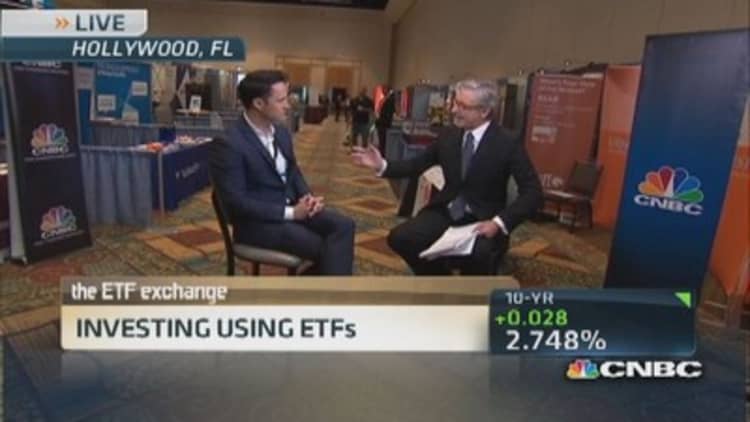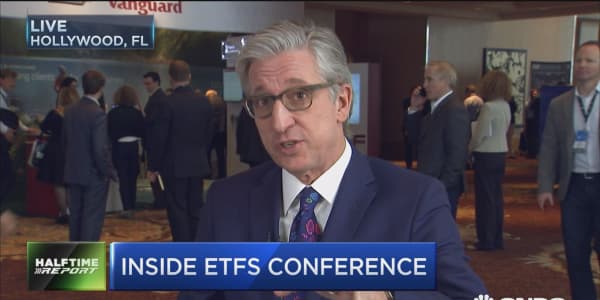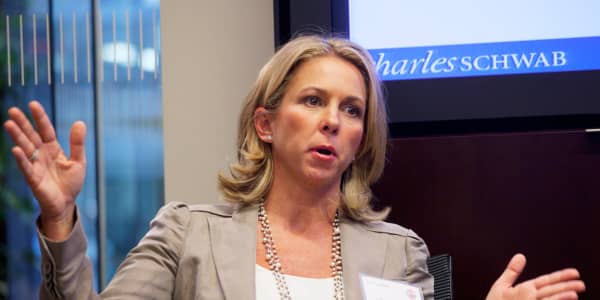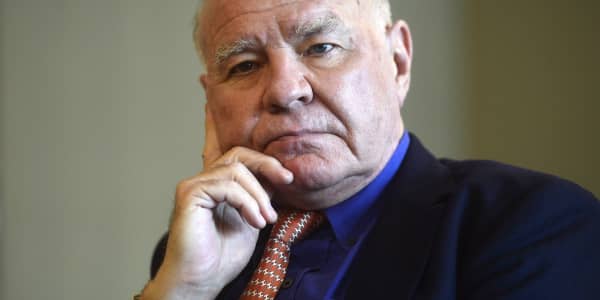
Investment advisors are gathered in Hollywood, Fla., for the ETF.com (formerly IndexUniverse) annual Inside ETFs conference. They are debating a tricky dilemma: What to do with emerging markets ETFs.
Why is that a problem? Because many of them have put their clients into emerging markets portfolios, and after four years of underperformance, questions are being asked.
Partly, it's the fault of academia—and the media that go along with them (ouch!). One of the tenets of Modern Portfolio Theory is that investors need to have a broadly diversified portfolio, since it can never be clear which sectors or countries will outperform. The theory is that diversifying across many asset classes poses less risk than putting all your eggs in one asset class.
Never mind that this theory has been challenged in recent years. Fact is, most of the world has bought into diversification. That's why we have so many strategists recommending that, say, 5 to 10 percent of your assets be in emerging markets.
(Read more: 2 ETF trends to finally kill the mutual fund)
This was a tough thing to do even as late as 10 years ago, but the rise of ETFs has made it a lot easier to invest in odd corners of the world. The iShares MSCI Emerging Market ETF (EEM) started in 2003, and the fact that it went straight up like a rocket all the way into the end of 2007 caused it to attract a huge amount of assets.
And so here we are: A lot of people have money in emerging markets ETFs because they've been told they need to have money there, even though most of these funds have gone nowhere for the past four years, a time when the S&P 500 is up more than 60 percent.
What happened? Call it the Politics of Index Construction: Most of the funds are built around the concept of BRICs (Brazil, Russia, India and China), with a heavy weighting to China. But slower growth in China and Brazil means most emerging markets ETFs—including the EEM, which has a near–20 percent weighting to China—have gone nowhere for four years.
Little wonder that every single large investment house I know of has an underweight rating on emerging markets for 2014.
Trading the chart
What to do? For those technically inclined, I point out that the EEM routinely moves in a "channel" between $35 and $50, but mostly it moves every six months or so between $35 and $45. Investors could treat the EEM as an old-fashioned channel stock: Buy it when it hits $35 or near there, and sell when it hits around $45. As of Jan. 27 midday, it was $37.79.)
Can a case be made to invest in emerging markets longer term? Sure, especially now. Valuations are compelling, arguably cheap. P/E ratios in many cases are half what they are in the U.S.
(Read more: ETFs 2014: 3 big risks, 3 big opportunities)
But there is a major X factor looming over this entire asset class: the U.S. Federal Reserve.
The big fear is that the Fed tapering program will end up strengthening the dollar, which will draw capital flows out of emerging markets.
This is a very real concern. If yields move appreciably higher in Treasuries, investors will pull money out of emerging markets currencies, bonds and stocks because the hunt for yields will subside somewhat. After all, why risk money in some foreign country, with all the attendant currency and political risk, when you can invest in the U.S. with decent returns?
This is not a theory: The EEM dropped 18 percent in May and June last year as the yield on the 10-year Treasury moved up roughly 80 basis points in that same time period.
Countries that have large current-account deficits will be particularly hurt by a sharp rise in U.S. interest rates—their currencies will weaken against the dollar. This may cause their central banks to intervene in their currencies, drawing down reserves and further weakening their economies.
(Read more: 5 things ETF investors should know)
The counterargument is that a gradual tapering, with gradually rising rates, will not be devastating to emerging markets.

Where to look
Another point made by emerging markets bulls is that there are many corners of the world not so heavily influenced by China, and in recent years some ETF providers have explored them:
1. The iShares MSCI Emerging Markets Minimum Volatility ETF (EEMV) attempts to buy the stocks with the lowest volatility in emerging markets. While roughly 20 percent of the fund is invested in Chinese stocks (similar to the EEM), this strategy has notably outperformed the EEM in the last couple years.
2. The WisdomTree Emerging Markets Equity Income Fund (DEM) measures the performance of the highest dividend-yielding stocks selected from the WisdomTree Emerging Markets Dividend Index. There is a more even distribution here between Europe, Asia, Latin America and Africa. Russia is the biggest country holding.
3. Other investors have pushed into single-country and frontier markets. One of the more talked-about ETFs last year was the iShares MSCI Mexico Capped ETF (EWW). More than any emerging country, Mexico benefits the most from the U.S. recovery. Eighty percent of its exports go to the U.S. The biggest problem: Mexico's main bourse is weighted toward only a few companies, such as Femsa and Cemex, so you are buying intense exposure to a small group.
4. The iShares MSCI Frontier 100 Index Fund (FM) consists of the 100 largest securities in select frontier markets ranked by float-adjusted market capitalization. This ETF is heavily weighted toward the Middle East (55 percent of holdings) and Africa (20 percent), so there is no exposure to Asia and very little to Latin America; much of what you own here are Middle Eastern banks. Nigeria—one of the current hot countries—is 12 percent of its holdings. It significantly outperformed emerging market ETFs last year.
The biggest problem many of these alternative-universe emerging markets ETFs have is currency exposure, one reason that WisdomTree Japan Hedged Equity ETF (DXJ) was arguably the most popular ETF in the U.S. last year: It bought into Japanese equities but hedged out the yen. Problem is, there are precious few currency-hedged emerging markets ETFs out there.
That's one reason why Deutsche Bank has been attracting some attention with its series of currency-hedged ETFs, including db X-trackers MSCI Mexico Hedged Equity ETF (DBMX) and db X-trackers MSCI Emerging Markets Hedged Equity ETF (DBEM).
More currency-hedged ETFs are coming. … There are many in registration—one of the hot topics at this conference.
—By Bob Pisani, CNBC "On-Air Stocks" Editor





